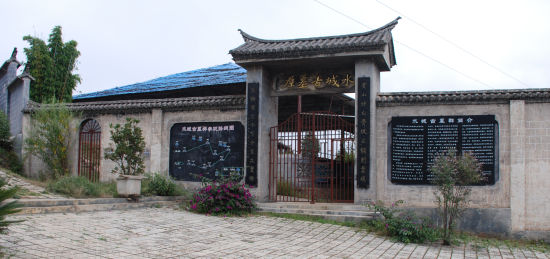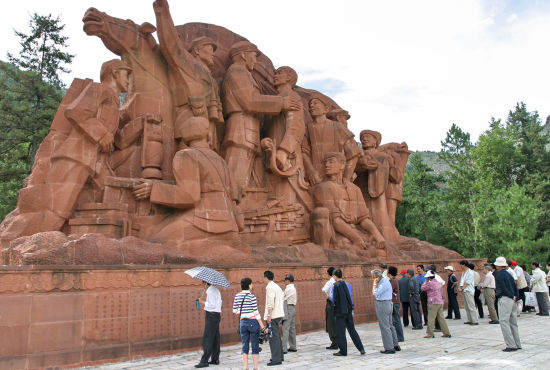Shuicheng Kuohong Cultural and Ecological Park in Huize County, Qujing
Overview
Shuicheng Kuohong Cultural and Ecological Park (水城扩红文化生态园, Shuǐchéng Kuòhóng Wénhuà Shēngtài Yuán) is located in Shuicheng Village (水城村, Shuǐchéng Cūn), 2 kilometers northwest of Huize County (会泽县, Huìzé Xiàn) in Qujing City (曲靖市, Qūjìng). This site holds significant historical importance as a key location of the Kuohong Movement (扩红, Kuòhóng) and has been developed as a tourist attraction according to the standards of a national AAAA-level scenic area. It serves as a base for youth revolutionary patriotic education and national defense education, being one of the seven listed sites in Yunnan Province recognized as part of the “National Hundred Classic Red Tourism Scenic Areas.”
Historical Significance
From May 1 to 4, 1935, the First Front Army’s Ninth Corps of the Chinese Workers’ and Peasants’ Red Army (中国工农红军第一方面军第九军团, Zhōngguó Gōngnóng Hóngjūn Dì Yī Fāngmiàn Jūntuán) passed through Huize. Led by Corps Commander Luo Binghui (罗炳辉), Political Commissioner He Changgong (何长工), and Political Department Director Huang Huoqing (黄火青), the corps carried out actions to eliminate local tyrants and offer relief to the people, while simultaneously spreading the principles of revolution.
During this time, the people of Huize actively participated in the revolution, with over 1,300 soldiers joining the Ninth Corps within just two days, marking the largest recruitment during the Long March (长征, Chángzhēng). The locals also helped gather military supplies, raising nearly 100,000 silver dollars and providing numerous mules for the troops. Huize became historically significant for its contributions to the Red Army during the Long March, making it a highlight of the revolutionary culture in the Wumeng Mountains (乌蒙山, Wūméng Shān).
Features of the Park
Shuicheng Kuohong Cultural and Ecological Park comprises several attractions, including:
- Kuohong Platform (扩红台, Kuòhóng Tái): A memorial site commemorating the Kuohong movement.
- “Wumeng Bangbo” Sculpture Group (乌蒙磅礴群雕, Wūméng Pángbó Qúndiāo): A large sculpture group that reflects the spirit of the Kuohong movement and the close relationship between the military and the people. The sculpture occupies an area of 2,637 square meters, measuring 18 meters long, 6 meters wide, and 11.7 meters high, weighing 550 tons.
- Huize Revolutionary History Memorial Hall (会泽革命历史纪念馆, Huìzé Gémìng Lìshǐ Jìniànguǎn): This hall features 12 red relief sculptures on its outer walls, depicting key historical events such as the Ninth Corps’ conquests and the close ties between the military and civilians. The exhibition hall showcases the revolutionary history of the Communist Party of China (中国共产党, Zhōngguó Gòngchǎndǎng) in Huize.
- Ancient Tombs and Ancient Pear Orchard (古墓群和古梨树园, Gǔmù Qún hé Gǔ Lìshù Yuán): The park explores the use of red resources alongside ancient relics and ecology, enriching the red landmark and enhancing its appeal as a tourist destination.
The park was established to commemorate the significant events that transpired during the Long March, as the Red Army left a lasting legacy of revolutionary spirit and hope for future generations.
How to Get There
- By Car: From Qujing City, drive northwest towards Huize County. Follow local signs to Shuicheng Village, where the park is located.
- By Public Transport: Take a bus from Qujing to Huize County and then utilize local transportation or taxis to reach Shuicheng Village.
Travel Tips
- Visiting Hours: Check the park’s opening hours before your visit, as they may vary by season.
- Respectful Conduct: Be mindful of the historical significance of the site and behave respectfully.
- Photography: While photography is allowed, please be considerate of other visitors and any restrictions.
- Learn the History: Familiarize yourself with the historical context to enrich your experience.
- Amenities: Bring snacks and water, as facilities may be limited within the park.
- Weather Preparedness: Check the weather forecast and dress accordingly, as some areas may lack shelter.
Shuicheng Kuohong Cultural and Ecological Park serves not only as a tribute to the revolutionary struggles but also as a vital educational site that reminds us to inherit and promote the spirit of the Long March in our pursuit of progress.


















